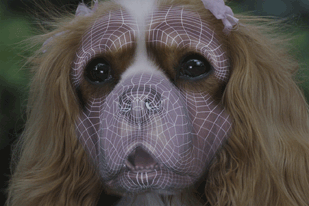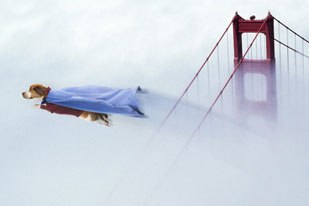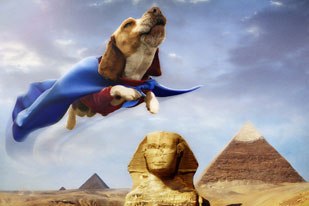Bruce Shutan talks with veteran vfx supervisor Hoyt Yeatman on teaming with Cinesite, Framestore-CFC and Realscan 3D to present a photorealistic portrait of Underdog.

Cinesite, Framestore-CFC (above) and Realscan lent their collective vfx artistry to keep moviegoers from distinguishing between the real pooch, and his digital double in Underdog. All images © Disney Enterprises.
Reality and make believe meld on Aug. 3 with the release of Underdog, Spyglass Ent. and Walt Disney Pictures' live-action adaptation of the 2D cartoon of the same name whose crime-fighting canine graced the small screen from 1964 to 1973.
But this dog's toughest trick won't be protecting the beleaguered citizens of Capitol City after routinely proclaiming: "There's no need to fear. Underdog is here!" It will be keeping moviegoers from being able to distinguish between the real pooch, a cooperative Lemon Beagle named Leo in the starring role, and his digital double. The same applies to a cast of fellow canines whose CG stand-ins provide a photorealistic portrayal designed to fool the eyes, boggle the mind and warm the heart.
It took a crack team of experts on both sides of the Pond to lend their collective vfx artistry to pulling off this impressive cinematic feat at a time when the creative and approval processes usually associated with producing digital animal doubles are both painstaking and no guarantee that high quality will prevail. One inherent challenge is getting animals to sit still long enough for a full-body scan, while another is that technical limitations have often produced inexact results.

Underdog showcases the work of Realscan 3D Inc., a mobile 3D scanning house whose proprietary technology is used to build exact digital doubles of talent and objects that can be matched quickly to live-action plates. Courtesy of Realscan 3D.
Leading the charge was Hoyt Yeatman, an industry veteran who served as the film's visual effects supervisor. He recruited several heavy hitters to realize director Frederik Du Chau's vision of a photoreal canine who could fly (unlike the animal caricatures found in Garfield, Stuart Little or The Adventures of Rocky & Bullwinkle), and dazzle a younger audience for whom realism is so critical.
They included Cinesite and Framestore-CFC facilities in London to post the project, which showcased the work of Realscan 3D Inc. in Redondo Beach, California, a mobile 3D scanning house whose proprietary technology is used to build exact digital doubles of talent and objects that can be matched quickly to live-action plates.
Realscan's RealCapture NexGen 3D scanning technology laid the groundwork for what each of the main players involved in vfx on Underdog considered unprecedented levels of detail and color in the pack of dogs on which the digital doggie doubles were based and completely convincing photorealism once all the finishing touches were made. Realscan's technology captures geometry and high-resolution texture in a single pass, moving around the subject with the use of a portable scanner that acquires subtle features and undercuts missed by fully automated systems.
The technical proficiency of this tool helped to pave the way for operational efficiencies that slashed time-consuming tasks from months to weeks and even days. The approach enabled Yeatman, who has worked on more than 100 movie, TV and commercial projects and won an Oscar for The Abyss, to focus on more strategic issues rather than worry about perfecting the animal likeness.

Realscan's RealCapture NexGen 3D scanning technology laid the groundwork for unprecedented levels of detail and color in the pack of dogs on which the digital doggie doubles were based. Courtesy of Realscan 3D.
All Eyes on HDRI
Indeed, Yeatman was able to develop a high dynamic range imaging (HDRI) lighting rig to speed the lighting and compositing time. A prototype unit was built to capture HDRI at the time of photography with key assists from a former partner from his days at Dream Quest Images and his brother in Switzerland, whose specialty is programming computer systems for equipment. Cinesite and Framestore-CFC used the HDRI for their respective post-production pipelines.
This was a huge help to David Eggby, the film's director of photography, who was able to light scenes in the both physical world and CG realm. His options would have been limited prior to this technology. Since color temperature, exposure value and other variables lose their meaning in a CG environment because of the virtual technology used to replicate the live action, most, if not all, of the assessments are done by the naked eye.

There were difficulties in the modeling and animation of some dogs. Cinesite developed a robust fur system to keep the shots straightforward.
"That takes a lot of time and it doesn't always capture the subtleties, especially with global illumination," observes Yeatman, who's building eight more HDRI composite units made of much-lighter carbon fiber material for future projects. The lighting rig clearly cast Yeatman in the vfx spotlight, earning him heaps of praise from the partners he hired.
HDRI was an intrinsic part of Cinesite's pipeline, although much of the lighting was done through traditional techniques accompanied by HDRI. Realscan's technology offered both vfx houses rough proportions and scale of the dogs, which were modeled primarily from live-action plates. Cinesite vfx supervisor Ben Shepherd calls Yeatman's HDR system one of the best onset visual effects tools ever made. "It worked so quickly and efficiently," he says. "The images it produced were excellent and bigger than we could ever need."
Framestore-CFC set up its lighting pipeline around the HDRI supplied, which served as a "fantastic reference" for Mike Mulholland, a CG supervisor for Framestore-CFC who worked on Underdog. He considers Yeatman one of the most technically knowledgeable supervisors he ever worked with, adding that Underdog produced the most complete set of on-set data he has come across.

Framestore-CFC focused on more than 300 fully CG shots (about 250 of which involved the dogs), creating and animating CG versions of Polly, the three German "Super" Shepherds and even Dinklage's Barsinister.
"We really benefited from all the on-set data that was captured using Hoyt's camera and the accompanying survey data that was also supplied," he explains. "We processed the HDRIs by convolving them to produce ambient and reflective representations of the HDR images, which were then used to directly provide the ambient and reflective components of the lighting. We were also able to use the HDRIs to extract our diffuse lights by sampling the color and intensity of the bright points in the image. This got us a long way into the lighting of shots comparatively quickly."
Joel H. Thornton, Realscan's founder and cto, describes Yeatman as "a visionary assembler of available technology" whose supervision illustrates how specialization can work in the vfx marketplace. "It's now possible to assemble a product at the quality of an ILM or a Weta by recruiting the best available talent in each area of expertise," he says. "What was previously only available to a studio through a handful of exclusive vfx houses is now simultaneously available to multiple studios and films."

Cinesite handled all the muzzle-replacement work, turning in 372 finished shots from a blend of the original tracked plates and matchmoved CG performance.
A Photoreal Action Star
The premise of Underdog is similar to Superman in that an ordinary character becomes a superhero. In this case, it's an unassuming dog named Shoeshine Boy (voiced by actor-comedian Jason Lee) -- a canine Clark Kent who develops an extraordinary ability to speak following an accident in the mysterious lab of maniacal scientist Dr. Simon Barsinister (Peter Dinklage). He's later transformed into a rhyming superhero who goes by Underdog.
Rounding out the colorful cast of canine characters were "Sweet" Polly Purebred (the protagonist's King Charles Spaniel love interest, voiced by Academy Award nominee Amy Adams), a Rottweiler named Riff Raff, German Shepherds known as Supersheps, a Bulldog, French Pug and Chinese Crested Crescent known as "The Crazy dog."
Cinesite handled all the muzzle-replacement work, turning in 372 finished shots from a blend of the original tracked plates and matchmoved CG performance. They involved replacing the nose, lips, teeth and lower jaw, as well as patches above those features and eyebrows. Framestore-CFC focused on more than 300 fully CG shots (about 250 of which involved the dogs), creating and animating CG versions of Polly, the three German "Super" Shepherds and even Dinklage's Barsinister.

Cinesite's work involved replacing the nose, lips, teeth and lower jaw, as well as patches above those features and eyebrows.
Their respective toolkits included all the usual suspects. For example, Cinesite used Pixel Farm's PF Track software to blend tracked plates and CG performance, as well as Maya for animation and lighting, Photoshop and Deep Paint 3D for texture, RenderMan for rendering and Shake for compositing. Framestore-CFC also used Maya to animate and light with the addition of many proprietary plug-ins, and RenderMan and Shake to composite the renders. Beyond that, Framestore-CFC used several combinations for modeling (LightWave and Maya) and texture (Photoshop and Bodypaint).
When Realscan came on board in December 2005, Yeatman had the luxury of plugging the boutique house into the vfx pipeline before animal or human talent had been cast. In the initial scanning session at Boone's Animals for Hollywood in Castaic, California, full-body animal scans were done of Shoeshine, Polly and one other prominent canine (voiced by Brad Garrett). Two months later, head scans were done of the entire Riff Raff Gang: an old Basset Hound, Shoeshine's Mother, Riff Raff Dog No. 1 and Riff Raff Dog No. 2. Then in April 2006, a full-body scan was done of Dinklage, along with a head-scan of "The Crazy Dog" on location in Rhode Island between takes so as not to interfere with principal photography.
CG techniques were used to augment Leo's image whenever Shoeshine spoke or flew through the air as his altar ego, Underdog. To facilitate the construction of his digital double, Leo had to be properly scanned. Quite a bit of attention was paid to the inside of a dog's mouth and how his tongue, teeth and throat worked nail the speaking scenes. A digital mask featuring elaborate controls to the face captured subtleties such as frowning.

Cinesite created a "whoosh" effect to capture Underdog's flight through the air at breakneck speed to a point where he appears as a blur on screen.
The CG dog had to be designed with musculature and pivot points that mirrored a real pooch, which accurate realscans would capture. Caught between the worlds of physics and imagination, the chief creative challenge for Yeatman and his vfx crew was to visually bring the script's action to life with regard to crashing through walls or scaling impossibly large objects so that it would be both believable and breathtaking.
Quality Control
The difficult task at hand involved translating a stylized 2D lead character into a live-action, photoreal action star. Yeatman was concerned the jerry-rigging associated with previous automated attempts at creating animal digital doubles would prove too difficult for use at the time of principal photography or time-consuming in post production. Such techniques included body casts or laser scans of the talent that required filling in the undercuts with inexact data or creating everything directly from reference shots, which resulted in an embellished rendition rather than exact replica of the subject.
Another quality-control issue involved doubt as to whether coloration would accurately capture different lengths of animal fur. And when coupled with the need for an animal to stand completely still for at least 30 to 60 seconds during scanning, automated systems lacked a practical application. The mere thought of keeping a shivering white dog motionless after being soaked in water or covered in powder has meant it's easier to hire sculptors or creature shops to build scale or life-size animal replicas.
But the trouble with this approach has been facing an approval process that's lengthy, expensive and prone to varying degrees of success involving CG versions of the animal. Knowing that it can take up to half a year to build, fur, groom, light, animate and capture the persona of a CG canine model before it's put into production, Yeatman sought to avoid a half-baked solution that could pose creative and logistical problems as revisions were made.
Realscan's use of multiple custom camera calibrations to more accurately capture the details of each animal won him over when he put vfx services out to bid. Tests showed the realism that could be acquired for hybrid filmmaking involving CG and live action made this technology well worth the investment.

The CG dog had to be designed with musculature and pivot points that mirrored a real pooch, which accurate realscans would capture. The difficult task involved translating a stylized 2D lead character into a live-action, photoreal action star.
Fur Factor
But that didn't guarantee smooth sailing on this project. There were inherent difficulties in the modeling and animation of some dogs based on their breed characteristics. For example, Shoeshine's floppy ears pulled toward his face, Polly's soft and fluffy face made it difficult to define clear facial expressions and the German Shepherds' panting required some tricky 2D clean up.
While nearly all of the unusual-looking Chinese Crested Crescent dog's face ended up as CG, Cinesite developed a robust fur system that kept his shots fairly straightforward. It also helped that Leo sported shorter hair, though capturing his nuances, as well as matching him perfectly in look and build, was much harder to accomplish. All of the vfx artists involved knew there was no room for any doubt in the moviegoer's eyes given how the film seamlessly cut between Leo and the CG dog.
Cinesite's detailed anatomical model defined and limited movement as appropriate to follow Du Chau's directive to keep the canine mouths as flexible as a 2D animator's line while staying within the realm of realism. A bespoke system was used to blend animation between different muscle shapes and form phonemes. Animation details in the dogs' eyebrows, subtle movements and 2D warps matched the dialogue, enhancing and improving the dogs' original performances.
Fur-duplication efforts paid considerable dividends on a spectacular shot featured in the trailer in which the velocity of Shoeshine's super-barking blew the bullying Riff-Raff's fur plumb off his back thanks to Maya's particle system. "This was a complex shot involving several effects issues: a split-screen with Riff-Raff's side-kick Bulldog, a muzzle replacement on Riff-Raff, a shock wave effect hitting Riff-Raff's CG body and, finally, the explosive fur effect," according to Shepherd.
Photogrammetry was used to derive the 3D model from original footage of each dog, which eyeballs independently confirmed in post. The modeling team studied anatomical references to create highly realistic skeletal and muscle systems for the dogs, which were rigged ready for animating.
The results were better than Mulholland thought they'd be given the challenges in cyberscanning fur to match specific animals, not just generic breeds, as well as the fact that the work involved moving creatures. On previous projects, he relied on educated guesses and heavy use of still images for reference or worked off scanned maquettes.

Once all the elements were brought together, Leo and his digital double were indistinguishable. No one had successfully achieved a method for scanning live animals before this.
One interesting side note was that Leo packed on a few pounds over the course of the shoot, which meant the scan taken at the start of production didn't bear an exact resemblance to his curtain call. Fortunately, he had a digital stunt double for the numerous crashing, fighting, landing and take-off sequences.
When Shoeshine is transformed into Underdog, his most impressive super power is an ability to move extraordinarily fast -- a "whoosh" effect Cinesite created to capture his flight through the air at breakneck speed to a point where he appears as a blur on screen. To accomplish this objective, the CG dog needed to be modeled accurately and animated to match subsequent sequences that cut back to Leo. Multiple passes of particles were combined with a fully CG animated dog using motion-vector analysis techniques.
Framestore-CFC created three action sequences in fully CG environments. They involved flying German Shepherds chasing Underdog at the top of the capitol building, Underdog flying away from an explosion after being buried in a tunnel deep into the earth and Underdog blasting into space by the force of an explosion before falling back to earth as part of a re-entry effect.
Satisfaction Guaranteed?
Once all the elements were brought together, Thornton marveled at the results of a live-action test plate in which Leo and his digital double were indistinguishable running around in circles on a front lawn. "As far as any of us knew, no one had successfully achieved a method for scanning live animals," he says.
There's no denying that moviegoers are becoming sophisticated and demanding more convincing digital doubles. The aim for Underdog is to please not only kids who routinely expect to be dazzled by gee-whiz imagery but also their nostalgic parents who grew up watching the cartoon on which this film is based.
"Many times whoever we end up animating wind up on the one-sheet," according to Yeatman. "So our technical and creative contribution to films is so much more important than it was five and six years ago. These characters that are now coming out are doing amazing things."
Bruce Shutan, a Los Angeles-based freelance writer, has written for several entertainment publications and websites, including Daily Variety, Weekly Variety, emmy, the 55th Annual Emmy Awards program, Below the Line News and Film Score Monthly.







